Exploring the role of experts’ knowledge in visualizations for cyber security
Fabian B ¨ohm *
University of Regensburg
No ¨elle Rakotondravony †
University of Passau
G ¨unther Pernul ‡
University of Regensburg
Hans P. Reiser §
University of Passau
1 I
NTRODUCTIONKnowledge-assisted visualization is a concept in information vi- sualization that incorporates the knowledge conversion processes into the design, implementation and the utilization of visualization tools. Four different knowledge conversion processes describe the exchange of knowledge between humans and machines [4, 8]:
Internalization encompasses the transformation of explicit knowl- edge (machine-readable and persisted in database [2]) into tacit knowledge (human knowledge, specific to each individual [2]) using a visual representation of the first one and making it accessible and understandable to the user. This process is implemented into any visual representation of data or information.
Externalization is the transfer of knowledge following the opposite direction of internalization. Common implementations let users ac- cess a pattern database or ontology used by automated analysis meth- ods. By using the visual interface to formulate new patterns, users transfer their tacit knowledge to the machine, making it machine- readable and therefore, translating it into explicit knowledge.
Collaboration describes the process of combining the tacit knowl- edge of two or more humans. We extend the description and interpret collaboration as a process of combining the tacit knowledge using visual interfaces. Although collaboration can be done without visual interfaces by direct communication between humans, tools should provide functional support for this process.
Combination is very similar to collaboration as it describes the ex- change of explicit knowledge between computers by including new explicit knowledge into an existing knowledge base. This process can work completely without visual interfaces.
We present a work in progress in which we study the implementation of the knowledge conversion processes in visualizations for cyber security. By doing so, we are able to explore the current role of experts’ knowledge in the VizSec community. Drawing from our preliminary results, we identify shortcomings in the support of two knowledge conversion processes within current literature.
1.1 Motivation and objectives
In the domain of cyber security, the expert knowledge is very crucial and needed to interpret and make sense of automatically generated analysis results like machine learning models or anomaly alerts. Au- tomated analysis methods often do not have the needed insight for those contextual decisions and therefore, security experts must be included in the decision process [5]. However, automated analysis methods are crucial to cope with the vast amount of raw data at hand.
They express their insights using visual representations. However, those visualizations for cyber security also offer an appropriate solu- tion to externalize the domain knowledge of security experts making it accessible for automated data analyses and other experts [8].
*
e-mail: fabian.boehm@ur.de
†
e-mail: nr@sec.uni-passau.de
‡
e-mail: guenther.pernul@ur.de
§
